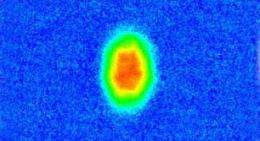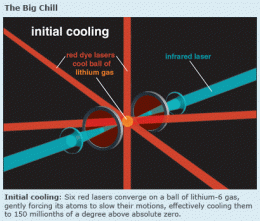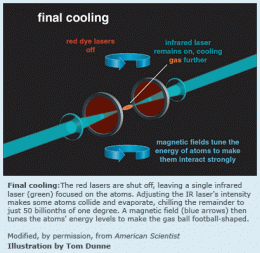Fire Meets Ice: Superhot And Supercold Remarkably Similar In The 'Fermion' World (w/ Video)

Trapping and cooling a microscopic clump of gas and then suddenly releasing it would normally result in the gas rapidly expanding outward in all directions, like a spherical bubble.
But what if it doesn’t? When a result doesn’t turn out as anticipated, nature may be revealing its secrets. And when the result also sheds light on Big Scientific Questions that weren’t even part of the experiment, researchers sit up and pay even closer attention.
That’s what’s been happening since Duke physicist did this experiment with lithium-6. The key was using only light to chill the gas to almost absolute zero and adding the right amount of magnetic energy, a combination pioneered in Thomas’s lab.
Instead of expanding evenly, the gas blob took the shape of a cigar standing on its tip. It then morphed asymmetrically within milliseconds into “this funny flow that stood still in one direction but expanded rapidly in the other,” recalls Thomas, an expert on the physics of ultracold temperatures and the university’s Fritz London Professor of �鶹��Ժics.
The stand-up stogie didn’t grow any taller, as Thomas noted with the aid of a microscope and time-freezing camera. But it bulged topsy-turvily in the middle, swelling into a kind of melon shape that shifted the overall orientation from vertical to horizontal.
In a much-cited report published in the Nov. 13, 2002 issue of the journal Science, Thomas’s research group suggested this phenomena pointed to a never-before-observed form of group behavior among this kind of gas’s frigid atoms.
It’s a condition that might help explain important phenomena that have been difficult to study, such as the flow of electrons in high-temperature superconductors, or the tightly bound nuclear matter in neutron stars, they said.Subsequent reports in Science and other journals firmed up the notion that the gas could be exhibiting the coordinated flow of a special kind of superfluidity — a strange liquid state in which very cold substances seem to move so effortlessly that nothing can stop them, in some cases even climbing walls.
At about the same time, researchers at the Brookhaven National Laboratory’s (RHIC) were getting intriguing results from their attempts to recreate the dawn of creation’s first white-hot microseconds. They did so by smashing together gold atoms propelled to nearly light speed, producing temperatures 150,000 times hotter than the sun’s interior within a time interval too fleet to measure.
This big bash at RHIC was supposed to liberate quarks — the fundamental units of all matter — from the gluons that normally hold them together, creating a hyper-energized gas called a quark-gluon plasma.
Using statistics and simulations to visualize what could not be seen, scientists discovered the plasma actually acts like a superhot fluid. And it behaves a lot like Thomas’s frozen cigars and melons. Both exhibit what the scientists called an “elliptic flow,” ballooning preferentially in only one direction. Thomas calls this “anisotropic expansion.” Soon illustrations from Thomas’s journal reports on the cold temperature experiment were being displayed at quark-gluon symposia — literally bridging the gap separating the very coldest from the very hot.
Further research suggested that although the systems exist at opposite extremes of temperature, both behave like “nearly perfect” fluids, flowing with practically no impeding viscosity.
Theorists involved in superstring physics have taken notice of this remarkable convergence. Some have begun using their complicated mathematical tools to bridge quantum mechanics and general relativity and explain why Thomas’s supercold world bears similarities to the superhot. Already some of their calculations have yielded insights.
“RHIC’s system is at about 2 trillion degrees, while we’re typically at one-tenth of a microdegree above absolute zero — 19 orders of magnitude difference in temperature!” Thomas says. In terms of density, “there is also about 25 orders of magnitude difference between theirs and ours.”
And yet, Thomas, the experts on quark-gluon plasma and string theorists came together in a single session at this year’s annual meeting of the American Association for the Advancement of Science in Chicago to describe “the surprising confluence of such different physics fields as a sort of perfect storm,” according to the magazine Science News.
To have a system that connects cold, condensed gases to high-temperature superconductors and neutron stars and then to quark-gluon matter and even string theory is pretty amazing,” Thomas said.
Various researchers are still exploring what these very different phenomena might have in common. But Thomas said the special behavior of his Lithium-6 gas is related to the nature of its atoms.
Lithium-6 is among many atomic isotopes classified as “fermions.” Greta Garbos of the atomic world because they “vant to be alone,” fermions are loners compared to their chummier alter-ego counterpart atoms, the “bosons.”
The key is the state of their “spins,” an electromagnetic trait that all fundamental particles possess. Fermions have an “odd” spin of 1/2, which means they cannot share the same energy states with each other. Bosons, on the other hand, actually prefer getting together. Previously only certain boson type atoms were known to exhibit the group behavior of superfluidity.
Protons, neutrons and electrons — the constituents of atoms — are fermions, too. Were it not for their mutual repulsions, “we would collapse,” says Duke theoretical physicist Berndt Mueller. “We’re made up of positively charged nuclei and negative charged electrons, which should attract,” he explains. “But those are also all fermions, so they try to keep away from each other.”
Thomas’s experiments test the limits of this repulsion by making fermions very cold. Cooled to 50 billionths of a degree above absolute zero and influenced by the weird principles of quantum mechanics, the atoms’ spheres of influence balloon to an incredible large millionths of a meter. They also crowd up as closely as nature allows.
His group was the first to both chill fermions low enough with laser beams and also trick them into behaving for a short time like they’re part of one big molecule. Turning up a magnetic field to just the right level makes them want to collide and pair up into what he calls a “strongly interacting system.” It’s their exceptional interactivity that produces the exploding-cigar effect and also makes his fermions flow like a nearly perfect fluid. They enter a realm known as “universal behavior,” where they emulate traits of other very different systems.That’s why scientists are now using strongly interactive fermions to model how high-temperature superconductors work.
“You can test the theory,” Thomas says. “It’s easier using our gas because it’s a very controlled system.”Universally behaving fermions also let researchers model microscopic properties within the densest of nuclear matter - something not readily tested on a distant neutron star.
This article by Monte Basgall has originally appeared in . Reprinted with permission of Monte Basgall.


















